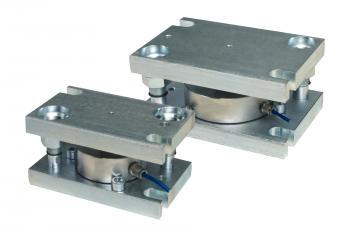Level Measurement by Weight
Accurate Inventory Control
It is often important to know the level of contents in a storage tank or silo for inventory control purposes. The consequences of a tank or silo running empty or being overfilled are expensive and, in some cases, dangerous.
Therefore, the measurement of the level of contents in a tank or silo is essential in many industries. When the level is nearly empty, further stocks must be ordered or there is a risk that production processes must stop until more material is delivered. When the level is nearly full, preparations must be made to stop the filling process before spillage occurs which can cause explosive or otherwise hazardous material to flow into unwanted areas, e.g. roadways, pedestrian areas or other storage tanks leading to contamination. All of these problems have expensive consequences.
Traditional Level Measurement Technologies
There are many different types of device used to determine the level of contents of tanks or silos, most of which rely on a signal being sent inside the vessel, for example using radar or ultrasonic waves, or even paddle-like sensors that come into contact with the stored material. Radar and ultrasonic level sensors usually send a single ray (or several rays) into the vessel at a fixed point and provide information about the distance from the sensor to the material surface directly below it and therefore the height of the material from the bottom of the silo or tank. Radar and ultrasonic level sensors are not reliable with materials that are hot, frozen, aggressive, non-free-flowing, non-self-levelling and those forming vapour, dust, mist or bubbles. Also, the shape of the silo or tank, the location of any filling/emptying ports and parameters such as storage temperature and viscosity can impact the reliability of these methods.
Consequently, many level measurement systems using radar or ultrasonic technology utilise multiple sensors and expensive software to process the multiple measurements and produce a complex, often unreliable, estimation of the ‘average’ level of the contents.
Use a 'Gravimetric' (weight) method for greater accuracy
A more cost effective, more reliable solution is to install load cells underneath the tank or silo to determine the level of its contents. This is called Gravimetric Level Measurement, or Level Measurement by Weight. The load cells will never come into contact with the contents of the vessel, therefore avoiding contamination of the stored product.
If the level of contents in the tank or silo is determined by weight, it may not be necessary for the weight of material to be measured with extremely high accuracy, as the only information usually required will be the silo status: ‘empty’ or ‘full.’ Therefore a level of accuracy from 1% to 5% may be sufficient in these situations and it is possible to use load cells with a level of precision that is lower than in applications where the exact weight is required. This gives rise to a very cost-effective solution, especially when compared with the cost of a single, or multiple, level sensors.
Our Solution: the T20 Weighing Assembly
The Model T20 weighing assembly (with a mounting accessory available in zinc plated steel or stainless steel) is a perfect fit for this application, as it can be installed quickly and simply for a low cost outlay. Level measurement by weighing is more reliable than the more traditional methods such as radar or ultrasonic waves. Where budget is the most important factor, dummy load cells can be used; for example a silo or tank with 4 legs could be fitted with 2 live load cells at opposite corners, with the other 2 legs having dummy load cells fitted. The accuracy will be lower than if all 4 legs are fitted with live load cells, but the system is more cost-effective.
Before the system is specified and installed, it is important to understand the material being stored and the accuracy required (as a percentage of the actual weight) to determine the best compromise between cost and accuracy.
The T20 load cell is protected to IP68/IP69K and has a Polyurethane cable as standard. Polyurethane has a high level of resistance to chemical attack, UV radiation, temperature changes and rodent bites. The load cell's accuracy level of 1000 divisions is more than sufficient for most gravimetric level measurement applications. The associated mounting accessory has integral lift-off protection and accommodates movement due to vessel expansion/contraction without passing lateral loads to the load cell.
System calibration
If you wish to have your gravimetric level measurement system calibrated or certified, many of our local weighing system Partners (who are experts in their field) will be able to supply calibration services. Please visit our Partner Network page to contact your local Thames Side partner, or Contact Us directly.
Further information
Contact Thames Side now to discuss your requirements for level measurement in silos or tanks.
We have the experience to provide expert guidance.









